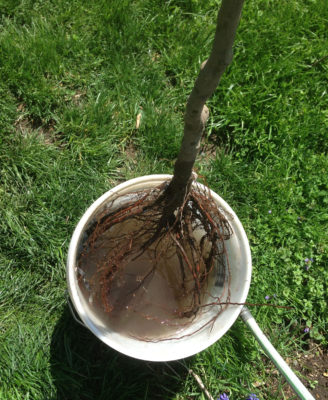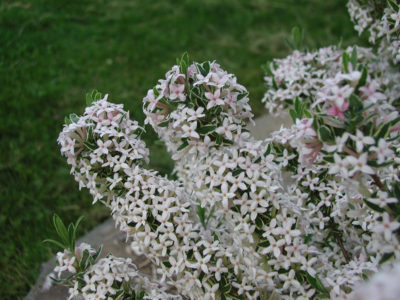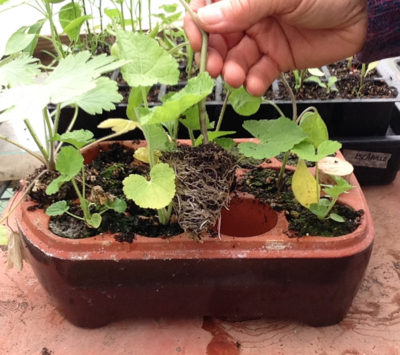SANS (fr.) / SIN (sp.) SOIL
Clarabel And Abbe Fetel
The UPS guy delivered two large, long boxes last week. Laid out in each box as in a coffin was what looked like a sturdy, 4-foot long stick. You wouldn’t think that either stick, one labelled Clarabel quince and the other labelled Abbe Fetal pear, could ever become a tree, could ever even come to life! Unpacking, then holding one of the sticks up, its bare roots dangling in the air, I had my doubts about the plant’s viability, even though I’ve planted many bare root trees over many years.

Bare root tree soaking
Bare root trees are grown at a nursery and, sometime between fall and spring while still leafless and dormant, are dug up, their roots shaken free of soil, and shipped. Before shipping a tree, a good nursery will tuck moist sphagnum moss, shredded newspaper, or other water retaining material in among the roots, then swaddle the roots and moist packaging all in plastic.
Some loss of large roots is unavoidable when digging a bare root tree. Less obvious is loss of tender root hairs. And roots don’t ever like being out of the soil. So why didn’t I just order a potted tree, which hardly need know that it’s been moved, rather than a bare root tree?
The main reason for buying a bare root Claribel quince or Abbe Fetel is because there’s not much chance of finding a potted one locally or, probably, anywhere. Bare root trees and shrubs are cheaper to buy and cheaper to mail than potted trees and shrubs, and are available in much greater variety.
Treated well, growth of bare root trees and shrubs will match that of their potted counterparts. Good treatment doesn’t end at the nursery. Soon after unpacking Claribel and Abbe Fetel, their roots were in a bucket of water, to soak for a few hours. Planting holes were dug just deep enough to set each tree at the same depth as at the nursery (as evidenced by the soil line on the trunk) and twice as wide as the spread of the roots. Abbe Fetal had a couple of straggly roots; I clipped them back to the same length as the other roots.
Holding a tree in place with one hand, I sifted soil back in among the spread roots in the planting hole, working the soil in amongst roots by poking with my fingers and occasionally bouncing the plant up and down slightly. After planting, a thorough watering further settled soil in amongst the roots. An icing of mulch — I used wood chips — and the plant, still looking like nothing more than a stick, was ready to go, as far as I was concerned.
Daphne . . . Alive
Last year I bought a potted Daphne bush at a local garden center. As I tipped the plant out of the pot to nestle into its waiting planting hole, all the potting soil fell away from the roots.
It’s not uncommon for a garden center to buy in bare root trees and shrubs, just as I did with Clarabel and Abbe Fetal, then pot them up for sale. Roots in some soil are ready to take in nutrients and water as soon as when warm weather coaxes out new leaves and shoots. Some weeks must pass before the roots actually grow out into the potting soil, though.
The Daphne was leafed out but hardly rooted when I tipped it out of the pot, making it again bare root. I had doubts about its survival. But it did survive. Still, it was an expensive bare-root plant.
Annuals In Cells
A hundred or so years ago, even tender, annual vegetable transplants were re-located to their new homes bare root. Tomatoes would be grown in cold-frames, hot beds, or greenhouses, then gingerly lifted free of the soil. Kept out of the sun and with their roots moist in a bucket of water, the plants were moved to the field or garden and planted, preferably on an overcast day. If the day was dry and sunny, a cedar shingle might be shoved into the ground to shade the plant for a day or two.

Transplant in Orto pot
These days, as you know, vegetable transplants come in plastic cell packs, each plant in its own mini-pot. For tender, small annual plants, potted is much better than bare-root.
Clarabel Has Risen
Resurrection! Only a few days after planting Clarabel and Abbe Fetel, and, like magic, green buds have swollen along the once dead-looking stems.

